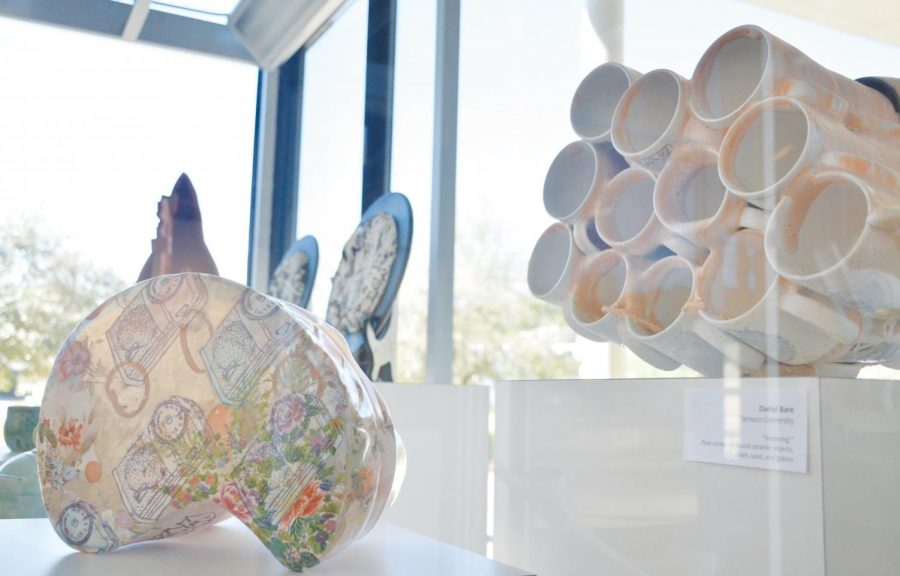Gallery displays wet-plate portraits, ceramics
Photo by: Thessalonia Thomas
Professor Doug Gray gathers the ceramics of different South Carolina professors in the “SC Clay > High Ed” exhibit.
The FMU Fine Arts Department is exhibiting two series in the Adele Kassab Art Gallery from Feb. 20-March 29: “Altered Realities: Photographs by Aspen Hochhalter” and the artwork of 22 ceramic teachers from 14 higher-education institutions in South Carolina in “SC Clay > Higher Ed.”
Gallery Curator Walter Sallenger said it was important to select an artist that will inspire students and the artistic community in Florence.
Sallenger said Hochhalter’s work similar to what photography students do in their upper-level classes at FMU.
Hochhalter, who is an associate professor of art and the photography area coordinator in the department of art and art history at the University of North Carolina, created two collections that comprise the “Altered Realities” exhibit.
Hochhalter said in her artist statement about the “92/20” series the very personal self-portraits speak to the construction and deconstruction of feminine identity.
Hochhalter created the 92 wet plate self-portraits in 20 days during the summer of 2011. She said the nature of self-portraits induces some apprehension about the public viewing them; however, their connection to her artistic creativity helps distance them enough from her personal appearance to exhibit them.
“It’s hard to be that vulnerable,” Hochhalter said. “But it’s interesting when I get in that mindset of photographing, it doesn’t feel like I’m photographing myself anymore; when I’m in that space, I feel like I take on a character. I don’t think of them as myself, so it doesn’t give me anxiety to put them out there.”
The other collection in the exhibit, “i must make my bones,” is a collaborative project between Hochhalter and Melissa Word, a professional modern dancer and choreographer, that she believes identifies with viewers because of the current cultural and political climate.
“The collaborative inspiration is based upon an Italian proverb, “devo farmi le ossa,” which translates, “I need to make my bones,” a phrase that I believe resonates with many people during our current cultural climate of upheaval, financial collapse and political uncertainty,” Hochhalter wrote in her artist statements about this collection.
Hochhalter also said since the artwork is an abstract self-portrait series in one sense, the artwork is not supposed to be specific, but be more about invoking a feeling of presence in one’s self.
The “SC Clay > Higher Ed” exhibit was put together for the first time at FMU by Professor of Fine Arts Doug Gray, who has worked with exhibition arrangement for 25 years and has artwork displayed in this exhibit. Gray said this exhibit was something he wanted to arrange for some time, and he wanted to organize it to see if the response would justify arranging a much larger sculpture exhibit.
A national sculptural exhibition inspired Gray. The exhibit never came close to FMU, and the only version of it in S.C. was held at Winthrop University’s campus. Grey said he wanted to work within the network of art faculty at different universities and colleges in South Carolina to create an exhibit, which he believes shows students an interesting snapshot of what is being done artistically in South Carolina among various educational institutions.
Elizabeth Keller, who is a visual arts professor at Coastal Carolina University, has work included in the “SC Clay > Higher Ed” exhibit. Keller said her primary inspirations and the areas in which she works are certain types of Chinese pottery and Chinese bonsai as well as creating sculptures that have great emphasis on texture and commonly feature teapot designs. Keller said she hopes the visual vocabulary she has developed over time and the specific kinds of technique she employs will benefit viewers.
“I hope it inspires people, particularly students, and gives them new ideas” Keller said.
